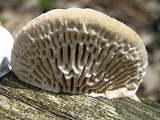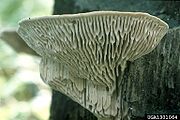
Daedalea quercina
Encyclopedia
Daedalea quercina is a species of mushroom in the Polyporales
order. It is the type species
of the genus Daedalea
. Commonly known as the oak mazegill or maze-gill fungus, the specific epithet refers to the oak genus Quercus, upon which it frequently grows, causing a brown rot
. It is found in Europe, Asia, Northern Africa and Australasia. Though inedible, it can be used as a natural comb and has been the subject of chemical research.
 The sessile
The sessile
, fan-shaped fruiting bodies are typically 3 – in diameter and up to 8 centimetres (3.1 in) thick. They are found singly or in tiered groups, usually on rotting oak. The upper surface of the cap may be various shades of brown, and is sometimes zonate. The pore surface, white to tan in color, is initially porous, but as the fruit body matures, some of the pore walls break down, forming slits with blunt partitions. This results in the characteristic maze-like (daedaloid or labyrinthinine/labyrinthiform) appearance. The tube walls are 10–30 mm long, with thick walls. The basidiospore
s are 5–7 × 2–4 µm
, smooth, and elliptical in shape. In deposit
the spores are white.
This mushroom is inedible due to its cork-like texture.
A variant has been described that has large, angular pores similar to those in the genus Trametes
, named D. quercina forma trametea.
It has been reported from nearly all European countries, following the pattern of oak distribution. It has also been reported in Northern Africa (Tunisia
), Asia
from Caucasus
to India
, and also Australia
.
This species has been investigated for application in bioremediation
. The lignin
-degrading enzyme
laccase
, isolated and purified from D. quercina, has shown use in biodegrading a variety of toxic dye
s and pigment
s.
The compound quercinol (a chromene derivative), isolated from the oak mazegill, has anti-inflammatory
activity, and inhibits the enzymes cyclooxygenase 2, xanthine oxidase
, and horseradish peroxidase
.
Polyporales
The Polyporales are an order of fungi in the class Agaricomycetes. The order includes some polypores as well as many corticioid fungi and a few agarics . Species within the order are saprotrophic, most of them wood-rotters...
order. It is the type species
Type species
In biological nomenclature, a type species is both a concept and a practical system which is used in the classification and nomenclature of animals and plants. The value of a "type species" lies in the fact that it makes clear what is meant by a particular genus name. A type species is the species...
of the genus Daedalea
Daedalea
Daedalea is a genus of fungi in the family Fomitopsidaceae. The genus was circumscribed in 1801 by mycologist Christian Hendrik Persoon, based on D. quercina and four other species .-External links:*...
. Commonly known as the oak mazegill or maze-gill fungus, the specific epithet refers to the oak genus Quercus, upon which it frequently grows, causing a brown rot
Brown rot
Brown rot may refer to the following diseases:*Wood-decay fungus, a disease of trees and wood.*Ralstonia solanacearum, a disease of plants caused by bacteria.*Monilinia fructicola, a disease of stone fruits....
. It is found in Europe, Asia, Northern Africa and Australasia. Though inedible, it can be used as a natural comb and has been the subject of chemical research.
Description

Sessility (botany)
In botany, sessility is a characteristic of plants whose flowers or leaves are borne directly from the stem or peduncle, and thus lack a petiole or pedicel...
, fan-shaped fruiting bodies are typically 3 – in diameter and up to 8 centimetres (3.1 in) thick. They are found singly or in tiered groups, usually on rotting oak. The upper surface of the cap may be various shades of brown, and is sometimes zonate. The pore surface, white to tan in color, is initially porous, but as the fruit body matures, some of the pore walls break down, forming slits with blunt partitions. This results in the characteristic maze-like (daedaloid or labyrinthinine/labyrinthiform) appearance. The tube walls are 10–30 mm long, with thick walls. The basidiospore
Basidiospore
A basidiospore is a reproductive spore produced by Basidiomycete fungi. Basidiospores typically each contain one haploid nucleus that is the product of meiosis, and they are produced by specialized fungal cells called basidia. In grills under a cap of one common species in the phylum of...
s are 5–7 × 2–4 µm
Micrometre
A micrometer , is by definition 1×10-6 of a meter .In plain English, it means one-millionth of a meter . Its unit symbol in the International System of Units is μm...
, smooth, and elliptical in shape. In deposit
Spore print
thumb|300px|right|Making a spore print of the mushroom Volvariella volvacea shown in composite: mushroom cap laid on white and dark paper; cap removed after 24 hours showing pinkish-tan spore print...
the spores are white.
This mushroom is inedible due to its cork-like texture.
A variant has been described that has large, angular pores similar to those in the genus Trametes
Trametes
Trametes is a genus of fungi that is distinguished by a pileate basidiocarp, di- to trimitic hyphal systems, smooth non-dextrinoid spores, and a hymenium usually without true hymenial cystidia. The genus has a widespread distribution and contains about fifty species...
, named D. quercina forma trametea.
Habitat and distribution
Although D. quercina prefers to grow on Quercus species, it has also been found on the tree species Fagus grandifola, Fraxina americana, Juglans nigra, and Ulmus americana.It has been reported from nearly all European countries, following the pattern of oak distribution. It has also been reported in Northern Africa (Tunisia
Tunisia
Tunisia , officially the Tunisian RepublicThe long name of Tunisia in other languages used in the country is: , is the northernmost country in Africa. It is a Maghreb country and is bordered by Algeria to the west, Libya to the southeast, and the Mediterranean Sea to the north and east. Its area...
), Asia
Asia
Asia is the world's largest and most populous continent, located primarily in the eastern and northern hemispheres. It covers 8.7% of the Earth's total surface area and with approximately 3.879 billion people, it hosts 60% of the world's current human population...
from Caucasus
Caucasus
The Caucasus, also Caucas or Caucasia , is a geopolitical region at the border of Europe and Asia, and situated between the Black and the Caspian sea...
to India
India
India , officially the Republic of India , is a country in South Asia. It is the seventh-largest country by geographical area, the second-most populous country with over 1.2 billion people, and the most populous democracy in the world...
, and also Australia
Australia
Australia , officially the Commonwealth of Australia, is a country in the Southern Hemisphere comprising the mainland of the Australian continent, the island of Tasmania, and numerous smaller islands in the Indian and Pacific Oceans. It is the world's sixth-largest country by total area...
.
Uses
Fruit bodies of D. quercina have been used as a natural comb, employed for brushing down horses with tender skin. Gilbertson notes that in England, smoldering fruit bodies were used for anesthetizing bees.This species has been investigated for application in bioremediation
Bioremediation
Bioremediation is the use of microorganism metabolism to remove pollutants. Technologies can be generally classified as in situ or ex situ. In situ bioremediation involves treating the contaminated material at the site, while ex situ involves the removal of the contaminated material to be treated...
. The lignin
Lignin
Lignin or lignen is a complex chemical compound most commonly derived from wood, and an integral part of the secondary cell walls of plants and some algae. The term was introduced in 1819 by de Candolle and is derived from the Latin word lignum, meaning wood...
-degrading enzyme
Enzyme
Enzymes are proteins that catalyze chemical reactions. In enzymatic reactions, the molecules at the beginning of the process, called substrates, are converted into different molecules, called products. Almost all chemical reactions in a biological cell need enzymes in order to occur at rates...
laccase
Laccase
Laccases are copper-containing oxidase enzymes that are found in many plants, fungi, and microorganisms. The copper is bound in several sites; Type 1, Type 2, and/or Type 3. The ensemble of types 2 and 3 copper is called a trinuclear cluster . Type 1 copper is available to action of solvents,...
, isolated and purified from D. quercina, has shown use in biodegrading a variety of toxic dye
Dye
A dye is a colored substance that has an affinity to the substrate to which it is being applied. The dye is generally applied in an aqueous solution, and requires a mordant to improve the fastness of the dye on the fiber....
s and pigment
Pigment
A pigment is a material that changes the color of reflected or transmitted light as the result of wavelength-selective absorption. This physical process differs from fluorescence, phosphorescence, and other forms of luminescence, in which a material emits light.Many materials selectively absorb...
s.
The compound quercinol (a chromene derivative), isolated from the oak mazegill, has anti-inflammatory
Anti-inflammatory
Anti-inflammatory refers to the property of a substance or treatment that reduces inflammation. Anti-inflammatory drugs make up about half of analgesics, remedying pain by reducing inflammation as opposed to opioids, which affect the central nervous system....
activity, and inhibits the enzymes cyclooxygenase 2, xanthine oxidase
Xanthine oxidase
Xanthine oxidase Xanthine oxidase Xanthine oxidase (XO (sometimes 'XAO'), a form of xanthine oxidoreductase that generates reactive oxygen species. Is an enzyme that catalyzes the oxidation of hypoxanthine to xanthine and can further catalyze the oxidation of xanthine to uric acid...
, and horseradish peroxidase
Horseradish peroxidase
The enzyme horseradish peroxidase , found in horseradish, is used extensively in biochemistry applications primarily for its ability to amplify a weak signal and increase detectability of a target molecule.-Applications:...
.

